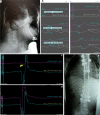Current approach on spinal cord monitoring: the point of view of the neurologist, the anesthesiologist and the spine surgeon
- PMID: 17619913
- PMCID: PMC2072895
- DOI: 10.1007/s00586-007-0419-6
Current approach on spinal cord monitoring: the point of view of the neurologist, the anesthesiologist and the spine surgeon
Abstract
Optimal outcome in spine surgery is dependent of the coordination of efforts by the surgeon, anesthesiologist, and neurophysiologist. This is perhaps best illustrated by the rising use of intraoperative spinal cord monitoring for complex spine surgery. The challenges presented by neurophysiologic monitoring, in particular the use of somatosensory and motor evoked potentials, requires an understanding by each member for the team of the proposed operative procedure as well as an ability to help differentiate clinically important signal changes from false positive changes. Surgical, anesthetic, and monitoring issues need to be addressed when relying on this form of monitoring to reduce the potential of negative outcomes in spine surgery. This article provides a practical overview from the perspective of the neurophysiologist, the anesthesiologist, and the surgeon on the requirements which must be understood by these participants in order to successfully contribute to a positive outcome when a patient is undergoing complex spine surgery.
Figures






References
-
- Auerbach JD, Schwartz DM, et al (2006) Detection of impending neurologic injury during surgery for adolescent idiopathic scoliosis: a comparision of transcranial motor and somatosensory evoked potential monitoring in 1121 consecutive cases. Russel Hibbs Award Winner: Scoliosis Research Society, Monterey, CA, 13–16 Sept 2006
-
- Brodkey JS, Richards DE, et al. Reversible spinal cord trauma in cats. Additive effects of direct pressure and ischemia. J Neurosurg. 1972;37(5):591–593. - PubMed
Publication types
MeSH terms
LinkOut - more resources
Full Text Sources
Other Literature Sources
Medical

